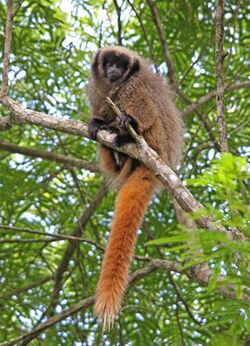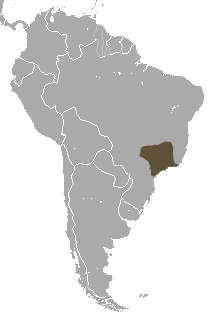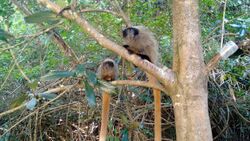Biology:Black-fronted titi
| Black-fronted titi[1] | |
|---|---|

| |
| Black-fronted titi in Prados, Brazil | |
| Scientific classification | |
| Domain: | Eukaryota |
| Kingdom: | Animalia |
| Phylum: | Chordata |
| Class: | Mammalia |
| Order: | Primates |
| Suborder: | Haplorhini |
| Infraorder: | Simiiformes |
| Family: | Pitheciidae |
| Genus: | Callicebus |
| Species: | C. nigrifrons
|
| Binomial name | |
| Callicebus nigrifrons (Spix, 1823)
| |

| |
| Black-fronted titi range | |
The black-fronted titi (Callicebus nigrifrons) is a species of titi, a type of New World monkey.
The black-fronted titi is a small diurnal primate.[3] The body of this primate is covered in grey to brown fur with black fur concentrated around the face, the tail is slightly orange in color.[4][5] Body weight ranges from 1 to 2 kilograms and the head-body length is around 270 to 450 millimeters.[4] This species does not exhibit sexual dimorphism.[5] Members of this species can live up to 12 years of age in captivity.[6]
Habitat and Distribution
The black-fronted titi is endemic to the Atlantic forest region of Brazil [7][8][4] and has a home range averaging 20 hectares.[8] The black-fronted titi is arboreal and prefers the middle to upper canopy of the forest.[5] However, it will move to the forest floor at times to forage, travel, and play.[9] Play behavior on the forest floor has been documented between black-fronted titis and marmosets in Brazil .[10]
Ecology
Diet
The diet of the black-fronted titi is frugivorous and they forage in dense vegetation.[5] They are also known to eat leaves, seeds, invertebrates, and flowers.[7][11][8] Due to their highly frugivorous diet, they play a key role in seed dispersion.[12]
Predation
Predators of the black-fronted titi include raptors, mammalian carnivores, snakes, and other primates.[5][3] Black-fronted titis are particularly vulnerable to raptor attacks when they move to the upper portion of the canopy to sunbathe on cold mornings.[5] After detecting a raptor black-fronted titis respond quickly using alarm calls and hiding.[5]
Behaviour
The black-fronted titi is socially monogamous[13][5][4] and is typically found in a group of two to six individuals, which includes the adult pair and their offspring.[9][4] Females give birth to one offspring per year, usually in July or August.[14] Parental care and social activities with the offspring are carried out by the male of this species, while the female only provides milk.[14] Both males and females disperse from their natal group at three years of age.[9]
The black-fronted titi is territorial and will defend territories, food resources, and mates with loud calls individually or in duets or choruses.[8][9] Loud calls are used for within and between group communication and have a high amplitude and a low frequency which allows them to be heard over long distances.[15] Loud calls are broadcast at dawn and when titis see or hear another group.[8] When confronted by a predator, duets and choruses can last up to two hours, with group members alternating between soft and loud calls.[16] There are no sex differences in calling behavior during predator interactions, both males and females will call.[5] The black-fronted titi can produce calls which encode the predator type (aerial or terrestrial) and predator location to nearby conspecifics.[17]
Characteristic of the Callicebinae subfamily, black-fronted titis can be observed with interwoven tails, a behavior thought to reinforce pair bonds and strengthen social relationships.[18][19][20]
Conservation
The black-fronted titi is classified as near threatened by the IUCN due to extensive habitat loss, forest fragmentation, and an estimated population decline of more than 20% in the past 24 years.[9] Small, isolated populations are common due to fragmentation and in some areas this has led to the species going locally extinct.[4] Noise pollution can also negatively impact this species. One study found that noise from mining operations restricted the black-fronted titis long distance communication due to the overlap in frequency between mining noise and loud calls, this is significant for a species that relies heavily on vocal communication in social interactions.[8]
References
- ↑ Groves, C.P. (2005). Wilson, D.E.; Reeder, D.M.. eds. Mammal Species of the World: A Taxonomic and Geographic Reference (3rd ed.). Baltimore: Johns Hopkins University Press. p. 144. ISBN 0-801-88221-4. OCLC 62265494. http://www.departments.bucknell.edu/biology/resources/msw3/browse.asp?id=12100338.
- ↑ Jerusalinsky, L.; de Melo, F.R.; Mittermeier, R.A.; Quadros, S.; Rylands, A.B. (2020). "Callicebus nigrifrons". IUCN Red List of Threatened Species 2020: e.T39943A17973667. doi:10.2305/IUCN.UK.2020-3.RLTS.T39943A17973667.en. https://www.iucnredlist.org/species/39943/17973667. Retrieved 19 November 2021.
- ↑ 3.0 3.1 Caselli, Christini B.; Gestich, Carla C.; Nagy-Reis, Mariana B. (2017-08-01). "Sleeping above the enemy: Sleeping site choice by black-fronted titi monkeys (Callicebus nigrifrons )". American Journal of Primatology 79 (10): e22688. doi:10.1002/ajp.22688. ISSN 0275-2565. PMID 28763579. http://dx.doi.org/10.1002/ajp.22688.
- ↑ 4.0 4.1 4.2 4.3 4.4 4.5 dos Santos, Glênio Pereira; Galvão, Cristiane; Young, Robert J. (2012-02-05). "The diet of wild black-fronted titi monkeys Callicebus nigrifrons during a bamboo masting year". Primates 53 (3): 265–272. doi:10.1007/s10329-012-0295-5. ISSN 0032-8332. PMID 22311072. http://dx.doi.org/10.1007/s10329-012-0295-5.
- ↑ 5.0 5.1 5.2 5.3 5.4 5.5 5.6 5.7 5.8 Cäsar, Cristiane (2012). Anti-predator behaviour of black-fronted titi monkeys (Callicebus nigrifrons).. University of St Andrews. OCLC 806194348. http://worldcat.org/oclc/806194348.
- ↑ Berthet, Mélissa; Mesbahi, Geoffrey; Duvot, Guilhem; Zuberbühler, Klaus; Cäsar, Cristiane; Bicca‐Marques, Júlio Cèsar (2021-10-05). "Dramatic decline in a titi monkey population after the 2016–2018 sylvatic yellow fever outbreak in Brazil". American Journal of Primatology 83 (12): e23335. doi:10.1002/ajp.23335. ISSN 0275-2565. PMID 34609763. http://dx.doi.org/10.1002/ajp.23335.
- ↑ 7.0 7.1 Caselli, Christini Barbosa; Setz, Eleonore Zulnara Freire (2011-08-23). "Feeding ecology and activity pattern of black-fronted titi monkeys (Callicebus nigrifrons) in a semideciduous tropical forest of southern Brazil". Primates 52 (4): 351–359. doi:10.1007/s10329-011-0266-2. ISSN 0032-8332. PMID 21861115. http://dx.doi.org/10.1007/s10329-011-0266-2.
- ↑ 8.0 8.1 8.2 8.3 8.4 8.5 Duarte, M. H. L.; Kaizer, M. C.; Young, R. J.; Rodrigues, M.; Sousa-Lima, R. S. (2017-09-11). "Mining noise affects loud call structures and emission patterns of wild black-fronted titi monkeys". Primates 59 (1): 89–97. doi:10.1007/s10329-017-0629-4. ISSN 0032-8332. PMID 28894994. http://dx.doi.org/10.1007/s10329-017-0629-4.
- ↑ 9.0 9.1 9.2 9.3 9.4 Berthet, Mélissa; Mesbahi, Geoffrey; Duvot, Guilhem; Zuberbühler, Klaus; Cäsar, Cristiane; Bicca‐Marques, Júlio Cèsar (2021-10-05). "Dramatic decline in a titi monkey population after the 2016–2018 sylvatic yellow fever outbreak in Brazil". American Journal of Primatology 83 (12): e23335. doi:10.1002/ajp.23335. ISSN 0275-2565. PMID 34609763. http://dx.doi.org/10.1002/ajp.23335.
- ↑ Souza-Alves, João Pedro; Mourthe, Italo; Hilário, Renato R.; Bicca-Marques, Júlio César; Rehg, Jennifer; Gestich, Carla C.; Acero-Murcia, Adriana C.; Adret, Patrice et al. (2019-10-01). "Terrestrial Behavior in Titi Monkeys (Callicebus, Cheracebus, and Plecturocebus): Potential Correlates, Patterns, and Differences between Genera" (in en). International Journal of Primatology 40 (4): 553–572. doi:10.1007/s10764-019-00105-x. ISSN 1573-8604. https://doi.org/10.1007/s10764-019-00105-x.
- ↑ Nagy-Reis, Mariana B.; Setz, Eleonore Z. F. (2016-08-02). "Foraging strategies of black-fronted titi monkeys (Callicebus nigrifrons) in relation to food availability in a seasonal tropical forest". Primates 58 (1): 149–158. doi:10.1007/s10329-016-0556-9. ISSN 0032-8332. PMID 27485746. http://dx.doi.org/10.1007/s10329-016-0556-9.
- ↑ Gestich, Carla Cristina; Nagy-Reis, Mariana B.; Caselli, Christini Barbosa (October 2019). "From dropping to dropping: The contribution of a small primate to seed dispersal in Atlantic Forest". Acta Oecologica 100: 103464. doi:10.1016/j.actao.2019.103464. ISSN 1146-609X. Bibcode: 2019AcO...10003464G. http://dx.doi.org/10.1016/j.actao.2019.103464.
- ↑ Souza-Alves, João Pedro; Caselli, Christini B.; Gestich, Carla C.; Nagy-Reis, Mariana B. (2019-02-20). "Should I store, or should I sync? The breeding strategy of two small Neotropical primates under predictable resource availability". Primates 60 (2): 113–118. doi:10.1007/s10329-019-00716-1. ISSN 0032-8332. PMID 30788624. http://dx.doi.org/10.1007/s10329-019-00716-1.
- ↑ 14.0 14.1 Cäsar, Cristiane; Young, Robert John (2007-10-16). "A case of adoption in a wild group of black-fronted titi monkeys (Callicebus nigrifrons)". Primates 49 (2): 146–148. doi:10.1007/s10329-007-0066-x. ISSN 0032-8332. PMID 17938856. http://dx.doi.org/10.1007/s10329-007-0066-x.
- ↑ Caselli, Christini; Mennill, Daniel; Bicca-Marques, Júlio César; Setz, Eleonore (2014-03-03). "Vocal behavior of black-fronted titi monkeys (Callicebus nigrifrons): Acoustic properties and behavioral contexts of loud calls". American Journal of Primatology 76 (8): 788–800. doi:10.1002/ajp.22270. PMID 24591251. https://onlinelibrary.wiley.com/doi/10.1002/ajp.22270.
- ↑ Narbona Sabaté, Lara; Mesbahi, Geoffrey; Dezecache, Guillaume; Cäsar, Cristiane; Zuberbühler, Klaus; Berthet, Mélissa (2022-01-09). "Animal linguistics in the making: the Urgency Principle and titi monkeys' alarm system". Ethology Ecology & Evolution 34 (3): 378–394. doi:10.1080/03949370.2021.2015452. ISSN 0394-9370. https://doi.org/10.1080/03949370.2021.2015452.
- ↑ Cäsar, Cristiane; Zuberbühler, Klaus; Young, Robert J.; Byrne, Richard W. (2013-10-23). "Titi monkey call sequences vary with predator location and type". Biology Letters 9 (5): 20130535. doi:10.1098/rsbl.2013.0535. PMID 24004492.
- ↑ Moynihan, M. (1966). "Communication in the Titi monkey, Callicebus" (in en). Journal of Zoology 150 (1): 77–127. doi:10.1111/j.1469-7998.1966.tb02999.x. ISSN 1469-7998. https://onlinelibrary.wiley.com/doi/abs/10.1111/j.1469-7998.1966.tb02999.x.
- ↑ "Titi monkey" (in en). 2016-04-25. https://nationalzoo.si.edu/animals/titi-monkey.
- ↑ Bezerra, BM; Ferrari, S; Boyle, SA; Veiga, LM (August 2009). "Pitheciine Action Group Newsletter". p. 13. https://ruffordorg.s3.amazonaws.com/media/project_reports/PAG%20newsletter%2C%202009.%20Volume%202%2C%20Number%203%2C%20pages%201%20-14.pdf.
Wikidata ☰ Q1350681 entry



